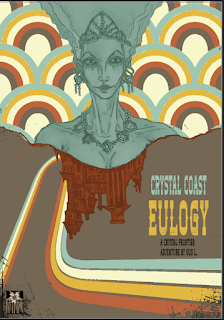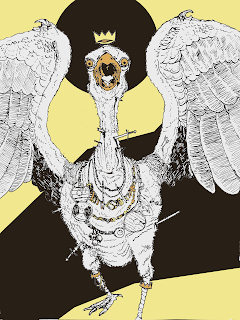Another year has passed, and my 11th blogging about old fantasy roleplaying games begins. Looking around the classic RPGand Post OSR community today I see a lot of folks talking about 2021, what lessons they took from it, what they accomplished. I won't. I learned nothing in 2021.
2021 was a bad year.
Plague. Death. Fire. Flood. Ignorance. Malice.
A year of mute calamity.
Sure, I put some adventures up on DriveThru RPG that got some ideas out of my head and which I hope some people enjoyed. I wrote some blog posts, including helping found the review site Bones of Contention, and managed to run 20 odd sessions of my Crystal Frontier home game, but 2021 is done.
NO PAST ONLY FORWARD
2022 is cracking from the egg now and I have some plans, hopes, and hobby aspirations. I've listed these projects below in rough order starting with the most possible and likely earliest to arrive.
1. CURSE OF THE GANSHOGGR
A 20ish page, fairy tale and saga influenced adventure for Ava Islam's Errant system. The Ganshoggr, a goose-dragon of prodigious size despoils the Goose Lands in the Empire of Birds as a mark of the avian gods' disapproval of the Goose King's war-making and misrule. The King wants it dead, his champions have failed and he certainly doesn't want to fight it himself.
Where brave goskarls have failed perhaps waves of greedy errants may succeed. The Ganshoggr dwells in the ancient barrows of the Anser Kings, hoarding tombgold and plunder. Challenge the Ganshoggr to single combat, unravel its mysteries and weaknesses, murder it in its sleep, or simply steal its hoard and leave the gooselands are turned to a guano poisoned marsh.

Powerful singular monsters in fantasy rpgs tend to be anti-climactic. It’s hard to overcome the action economy or the players’ schemes without making something that can utterly destroy the party without a second thought. The Ganshoggr is an attempt to instead create a dragon that is 1) Very dangerous to confront, almost impossible even 2) Has clear fairy tale “rules” for how it acts 3) Offers alternative means to defeat and has discoverable weaknesses.
2. CRYSTAL COAST EULOGY |
Draft Cover
|
Tomb Robbers deserves a sequel, but rather then investigate further fallen fortresses and sepulchers of the Empyreans (though I hope to get back to that), I've decided to focus on another part of the blasted frontier. Around the Bay of Falling Stars at the Northeastern edge of the Crystal Frontier is a rugged coast, largely abandoned, but less magically poisoned then the plains where the crystal tombs fall.Instead this land is mired in ignorance, feuds and old evil. The town of Coldwater rots inland, from the pirate shadowed cliffs and coves, once a plaything of the wealthy Cold family, and now isolated and failing. Obsessed with their customs and artistic pretensions the people of Coldwater ignore the ruins of Cold Manse, burned by revolutionary violence and pretend that families don’t disappear from Coldwater in the night. The Manse is of course haunted, and despite the best efforts of their persecutors, the Cold Family endures.
Demon worshipers and beneficiaries/victims of the Blackheart Contagion, the Colds have endured because they are scheming, immortal cannibals hiding in the undercrypts of their ruined mansion and focused on their own aristocratic pretensions: religion, art, esoteric scholarship and gastronomy. Yet the Younger Colds chaff at the rule of their elders (and the cruel punishments that await family members who defy them) providing for faction conflict and intrigue as well as exploration and the catharsis of massacring ghoulish aristocrats.
Crystal Coast Eulogy is also an experiment for me, a break with Tomb Robbers of the Crystal Frontiers dense “Jewelbox” style in an effort to create an adventure that still offers faction intrigue and puzzle opportunities, but is less dense to support greater focus on navigation and classic exploration within the limitations of OSE or B/X’s movement systems and exploration procedure. The main problem I have with the B/X exploration procedures is that like all early D&D exploration they seem to assume a far longer session time then online play supports. This is turn demands larger dungeons for them to function well, and larger dungeons are near impossible to write in my preferred style.
 |
Interior Design Draft
|
My hope is that by using streamlined descriptions for many of the keys, and saving denser descriptions for around 20 important areas I can write a 100+ key dungeon without losing too much detail and setting. Likewise I want to see how well I can design a dungeon for these procedures that functions with shorter sessions which means lots of entrances, shortcuts and discrete sections of the dungeon. Not a full on nodal mega-dungeon, with small sections split by procedurally generated, scale enlarged or otherwise simplified empty regions, but a fully keyed large dungeon that is functional without ignoring movement speed and supply or demanding players explore it in six hour sessions.
While much of Cold Manse is a reference to the Ghormenghast novels, another aspect of Eulogy that I'm interested in is creating a haunted house - a close look at the cover image may see the influence of Disney's Haunted Mansion, and the interior is likewise intended to be filled with ghosts and phantoms that don't follow the standard Dungeons & Dragons structure for undead encounters. There's still a lot of work to do on Crystal Coast Eulogy, but I've play tested some of the first level, and it went well, so I think it's just a matter of sitting down and writing another 60 keys. Then the layout and art of course...
 |
Draft Cover
|
3. CRYSTAL COAST REQUIEM
A companion to Eulogy, this is a regional point crawl with another dungeon (an abandoned lighthouse and shrine to the Imperial Saint of drowned sailors). Cold Manse from Eulogy will be the tentpole dungeon of the region, but it has other things going on, allowing referees with both books to run a region low level campaign. Rather then purely a gazetteer, Crystal Coast Requiem provides details and travel rules for a sub region of the Crystal Frontier, based loosely on the coast of Northern California. Faction and regional conflict, capable of quickly accelerating into a range war.
The core of Requiem is work I did in 2017 to support the re-release of Prison of the Hated Pretender, another dungeon with extensive notes -- instruction on the goal of the design or how to run it. Requiem focuses on faction intrigue, both within its dungeon and at the regional level, allowing the players to reshape the faction structure based on their actions.
I've also got a few other things planned or partially thought through, but the three projects above are the ones I hope to complete. For blog posts and reviews I'm currently writing up Part II of my look at treasure design, a post on the use of random tables in adventure design and another on the problems with nostalgia in the RPG community and design. For Bones of Contention I'm currently reviewing the re-release of Deep Carbon Observatory and looking at its place as an exemplar of mid-OSR design, as well as how it's various and varied experiments in adventure design hold up.





















